Dorylus (Dorylus) affinis Shuckard
 Male Male   Type location Gambia
(Dorylus affinis, Shuckard,
1840c: 316, male; Emery, 1901c: 189, worker; van Boven,
1975: 189, queen) from Gambia River - see below Type location Gambia
(Dorylus affinis, Shuckard,
1840c: 316, male; Emery, 1901c: 189, worker; van Boven,
1975: 189, queen) from Gambia River - see below
subspecies
denudatus (Dorylus
denudatus n. sp., Santschi, 1910g: 742, illustrated, male) from
Haut Niger, M Claveaux - see http://www.antweb.org/specimenImages.do?code=casent0911323
loewyi (Dorylus
affinis, Shuck. subsp. Löwyi n.
subsp., Forel, 1907b: 202,
male) from Tanzania, Zanzibar - see below
parapsidalis (Dorylus affinis Shuck. v. parapsidalis
n. var,
Santschi, 1917c: 20, male) from Malawi, Blantyre, Naklin Barat,
31.x.1907, G
Arnold - see http://www.antweb.org/specimenImages.do?code=casent0911333
ugandensis (D. affinis,
var. ugandensis, nov., Santschi, 1914b: 59, male) from Uganda,
Unyoro - no images on Antweb (June 2014)
junior
synonyms
brevinodosus (Typholopone oraniensis variety brevinodosa,
Mayr, 1862: 737, worker; synonymy Emery, 1901c: 189) from Ghana,
Quittah and Accra, by Dr Brauns - see below
planiceps (Dorylus
plancipes, Haldeman,
1849b: 204, male; synonymy Emery, 1895j: 719) from " West Africa"
unavailable names
badior (Dorylus (Dorylus) affinis stirps exilis
v. badior n. var.,
Santschi,1939b: 237, male) from Zimbabwe - see http://www.antweb.org/specimenImages.do?code=casent0911325
exilis (Dorylus
affinis, Shuck. stirps. Löwyi For. var. exilis n. var., Santschi, 1914b:
59,
male) from Tanzania, Kibosho - see http://www.antweb.org/specimenImages.do?code=casent0911324
all forms known
(see Bolton (1995)  . .
|
As shown on the linked page, fresh males from Sudan
match Mayr's description of aegyptiacus and are quite distinct
from the type. Thus, I have raised the variety to species status Dorylus (D.)
aegyptiacus, including the hirsutus
male from Ethiopia and "brevinodosus" workers from
Eritrea (Emery, 1915g).
As shown on the linked page, fresh males from the Central
African Republic match Santschi's description of pulliceps
and are quite distinct from the type. Thus, I have raised the variety
to species status Dorylus
(D.) pulliceps.
As shown on the linked page, fresh males from Mali
match Santschi's description of sudanicus and are quite
distinct from the type. Thus, I have raised the variety to species
status Dorylus
(D.) sudanicus.
I suspect the same separation of distinct species is
likely to hold also for the East African forms but without fresh
specimens or sight of all the type forms, I cannot determine that.
The
type males of badior, denudatus (apart
from being a rubbed specimen) and
parapsidalis (links
above) appear identical to the
affinis type male.
|
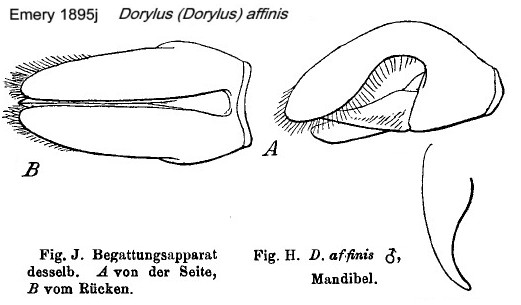 Shuckard's
(1840c) description is at Shuckard's
(1840c) description is at  . Haldeman's (1849b) description of the
male planiceps (spelt plancipes) is at . Haldeman's (1849b) description of the
male planiceps (spelt plancipes) is at  . Mayr's (1862) brief note on brevinodosus
is at . Mayr's (1862) brief note on brevinodosus
is at  . .
|
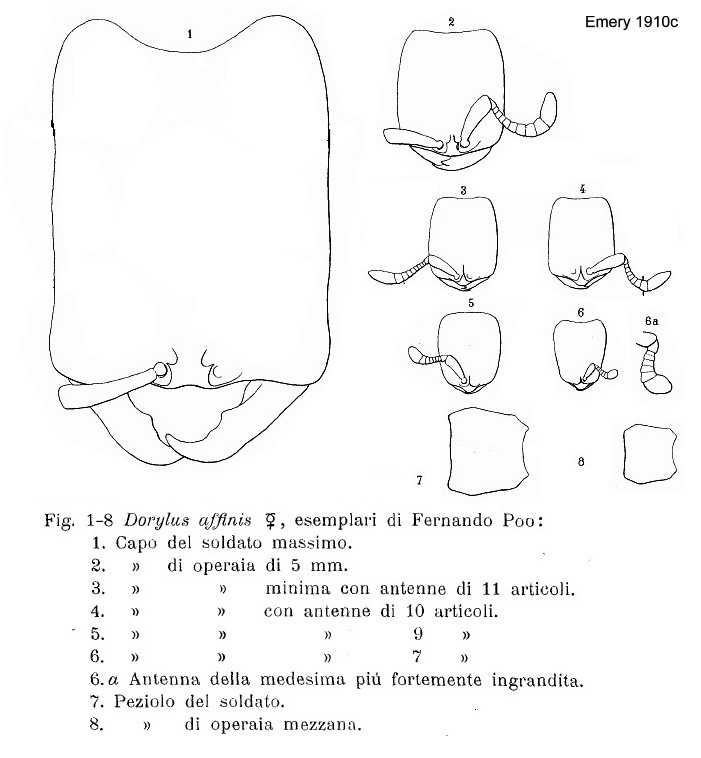 Emery
(1901c: 189, summarised and
illustrated the worker polymorphism, this is at Emery
(1901c: 189, summarised and
illustrated the worker polymorphism, this is at  . Emery (1895j: 720) gave a full,
illustrated, description of the male, plus abyssinicus; this is
at . Emery (1895j: 720) gave a full,
illustrated, description of the male, plus abyssinicus; this is
at  . Emery (1895j) provided the images (right)
drawn from the types of brevinodosus in Mayr's collection, with
a description at . Emery (1895j) provided the images (right)
drawn from the types of brevinodosus in Mayr's collection, with
a description at  . Forel's (1907b) description of the loewyi
male is at . Forel's (1907b) description of the loewyi
male is at  . Santschi's (1910g)
description of exilis is at . Santschi's (1910g)
description of exilis is at  . Santschi's (1910g) description of denudatus
is at . Santschi's (1910g) description of denudatus
is at  . Santschi's (1914b)
description of ugandensis is at . Santschi's (1914b)
description of ugandensis is at  . Santschi (1917c) constructed a key to the
males of the numerous varieties already known by that time; this, with
his description of pulliceps, sudanica is at . Santschi (1917c) constructed a key to the
males of the numerous varieties already known by that time; this, with
his description of pulliceps, sudanica is at  . Santschi's (1939b)
description of badior is at . Santschi's (1939b)
description of badior is at  from Zimbabwe. from Zimbabwe.
|
 Arnold
(1915: 120) had the following description - Arnold
(1915: 120) had the following description -
"The minors of this species are very similar to those of helvolus
and brevipennis; helvolus is more strongly and closely
punctured on the head, and does not reach to such a large size in
majors or maxima. From brevipennis, the workers of this species
can be distinguished only with difficulty, the main distinction being
the shape of the petiole, as given in the key above [petiole not much
wider behind than in front; brevipennis wider behind].
TL of maxima 10-11 mm. Head, from 3.3 mm long x 2.6 mm wide, to 3.7 mm
long x 2.8 mm wide.
The colour is like that of helvolus, the abdomen is lighter
than the thorax. Head shining, mandibles finely reticulate and sparsely
punctured; dorsum of the pro- and mesonotum smooth, propodeum
reticulate and dull, the opacity being due to a microscopic rugulosity.
The puncturation of the gaster is shallower and less abundant than on
the head. The petiole is duller than the thorax, and the puncturation
feebler and less regular. The gaster is shining, shallowly and sparsely
punctured. All the punctures bear short hairs, intermixed with which on
the gaster are some longer semi-erect hairs. There are a few pilous
hairs on the ventral surface of the gaster, the clypeus, mandibles and
pygidium; the hairs on the legs are comparatively longer and more
abundant than in helvolus.
The head is sub-rectangular, the posterior margin deeply excised, the
sides more or less feebly bisinuate. The mandible is acute at the apex,
with a pre-apical tooth at about the middle of the inner margin, and a
rudiment of a sub-apical tooth. The frontal carinae are a little
separated in front, but converge abruptly above the antennal sockets,
and each ends in a sharp spine pointing obliquely backwards. The
petiole is wider than long, widest posteriorly; it is comparatively
larger than in helvolus. The tooth-like projections of the
pygidium are not quite so prominent, otherwise similar to helvolus.
Worker minor - TL 8-5.5 mm. Head, 2.6 mm long x 3 mm wide, to 1.7 mm
long x l.4 mm wide. The posterior margin of the head is less deeply
excised, the sub-apical tooth of the mandible larger, nearly equal to
the pre-apical. The puncturation is finer, and the pubescence a little
more distinct, and the colour lighter than in the major.
Worker minima - TL 3.5 mm or less. In these the anterior margin of the
clypeus is more projecting, the frontal carinae are closer together and
less acute posteriorly, or in examples 3 mm long, with the spinous
processes entirely obsolete. Antennae with 7-8 joints, all the joints
of the funiculus, except the 1st and last, much wider than long. The
whole body is shining, and the colour dirty ochreous.
I am not aware of this species having been recorded so far from the
region (Southern Africa) dealt with in this work, but have included it
as it may perhaps be found in the future within the species, but has
been recorded from the southern Belgian Congo, (G.A. coll.)".
A very widely distributed species from throughout
tropical Africa; West African records include Senegal (Dakar,
F. Silvestri), Guinea Bissau (Bamabaya, by Lucas), Guinea (Conakry
and Camayenne, F. Silvestri), Liberia (Cape Palmas, by
Savage), Ghana (at Kitta and Accra, H. Brauns) and Cameroun
(by Conradt).
Bernard (1952) reported it as "frequent" in Lamotte's
collections on the Mt. Nimba massif, Guinea:- T44 (Nion); T42,
Mount Tô, Camp I, 1600 m (the richest number of workers). He noted it
had a dark mahogany colour and head shape like that of race loewyi
and puncturation and petiole form of variety pulliceps.
The
photomontage of a syntype brevinodosus
worker is collated from http://www.antweb.org/specimen.do?name=casent0915640.
|
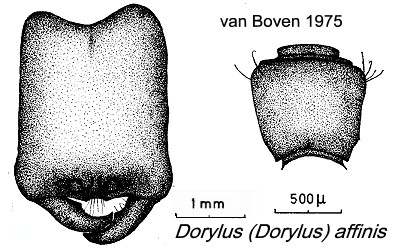 J.
van Boven (1975: 189) gave notes on the queen and gave a better
illustration (right) of the major; see J.
van Boven (1975: 189) gave notes on the queen and gave a better
illustration (right) of the major; see  . .
|
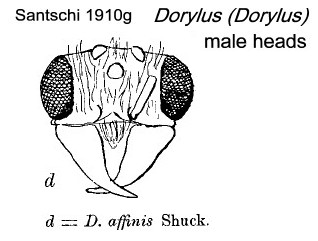 
|
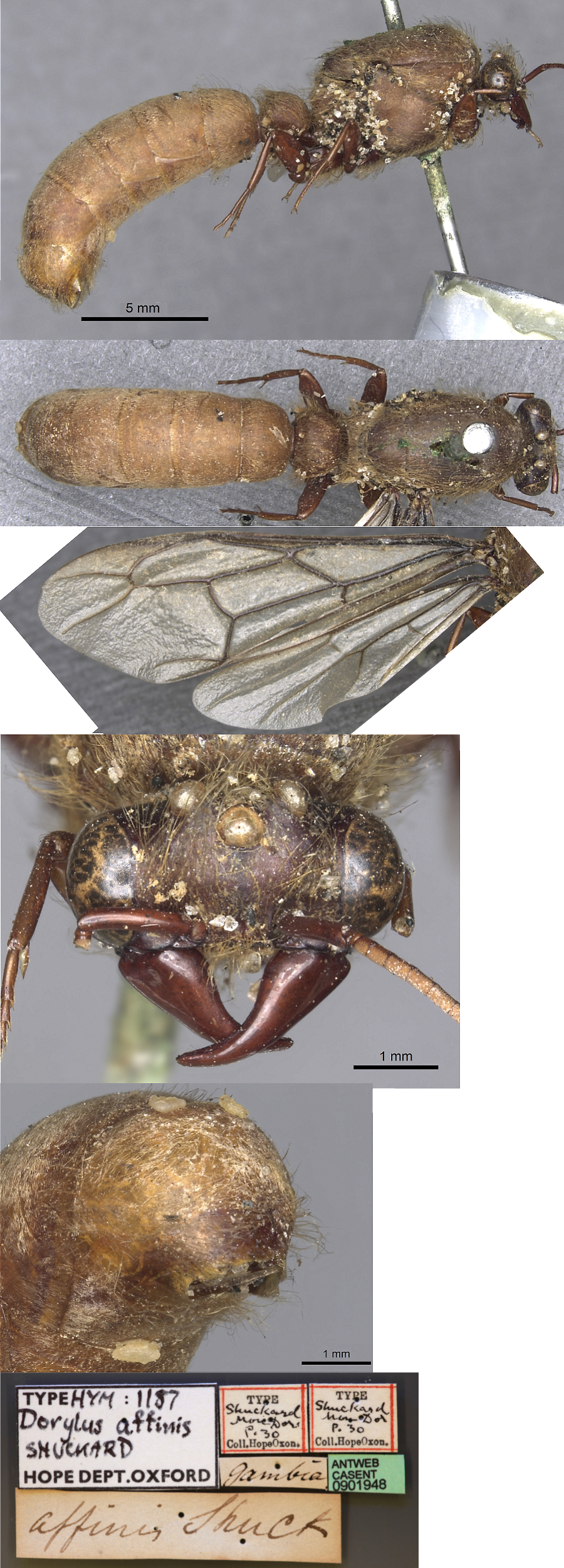 The
photomontage is of the holotype male collated from http://www.antweb.org/specimen.do?name=casent0901948. The
photomontage is of the holotype male collated from http://www.antweb.org/specimen.do?name=casent0901948.
|
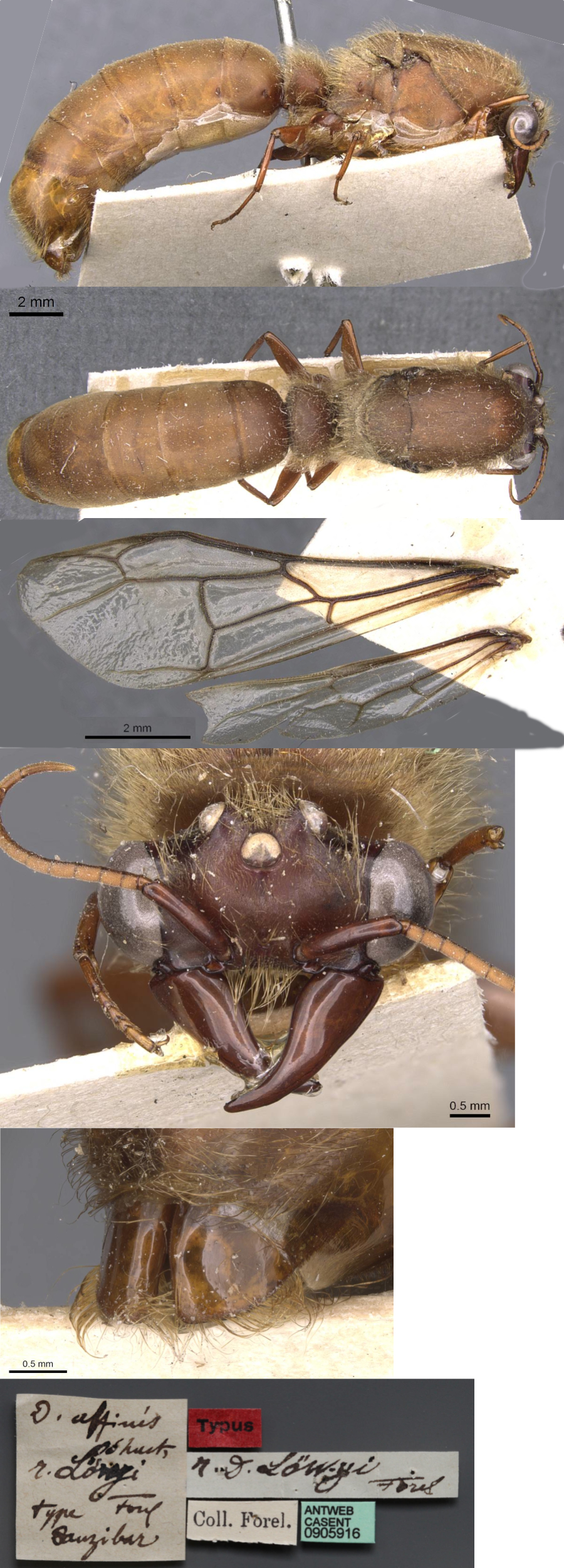 The
photomontage is of the loewyi male collated from http://www.antweb.org/specimen.do?name=casent0905916. The
photomontage is of the loewyi male collated from http://www.antweb.org/specimen.do?name=casent0905916.
|
Oxford University Museum
specimens
Dorylus (Dorylus) affinis
B Taylor det.
Male
|
Central African
Republic
P Annoyer
HI
|
13.x.2008
Dzanga-Sangha
04°22'19.4" N
18°35'49.7" E
|
360 m; Camp 1;
17h30-3h;
A la base de l'Ayous (Triplochiton
scleroxylon, Sterculiaceae) à 50 m du Camp
|
4
|
 |
Dorylus (Dorylus) affinis
B Taylor det.
Male |
Central African
Republic
P Annoyer
HE |
06.x.2008
Dzanga-Sangha
04°22'19.4" N
18°35'49.7" E
|
360 m; 24h30-4h;
Bangui après la corniche direction N'garagba
|
1
|
|
Dorylus (Dorylus) affinis
B Taylor det.
Male
|
Central African
Republic
P Annoyer
IB
|
13.10.2008
Dzanga-Sangha
03°03'58.3" N
16°08'59.6" E
|
528 m; Camp 1;
17h30-3h;
A la base de l'Ayous (Triplochiton
scleroxylon, Sterculiaceae) à 50 m du Camp
|
1
|
 |
Dorylus (Dorylus) affinis
B Taylor det.
Male |
Central African
Republic
P Annoyer
IG
|
14.x.2008
Dzanga-Sangha
03°03'58.3" N
16°08'59.6" E
|
Camp 1;14.x.2008;
Journée; Au camp
|
1
|
|
Dorylus (Dorylus) affinis
B Taylor det.
Male |
Central African
Republic
P Annoyer
HS
|
10.x.2008
Dzanga-Sangha
3°01'49.5" N
16°08'31.7" E
|
567 m; Camp de
transit 2; 18h30-3h;
Au dessus d'une chute d'eau (ruisseau Songo 1) à proximité du camp
|
1
|
|
Dorylus (Dorylus) affinis
B Taylor det.
Male |
Central African
Republic
P Annoyer
IN
|
14.x.2008
Dzanga-Sangha
03°03'58.3" N
16°08'59.6" E
|
528 m; Camp 1;
21h10-3h
Sur plate-forme à 54 m du sol dans un Ayous (Triplochiton scleroxylon,
Sterculiaceae) à 50 m du camp
|
3
|
|
Dorylus (Dorylus) affinis
B Taylor det.
Male |
Central African
Republic
P Annoyer
Camp 2
|
20-24.x.2008
Dzanga-Sangha
03°01'49.5" N
16°08'31.7" E
|
567 m; Polytrap at
44m dans l'arbre, 20-24.x.2008
|
2
|
 |
|
 The
photomontage is of a male from the Central African Republic,
Dzanga-Sangha NP; collector Philippe Annoyer (CAR IB). This is an
exact match for the type male shown above. The
photomontage is of a male from the Central African Republic,
Dzanga-Sangha NP; collector Philippe Annoyer (CAR IB). This is an
exact match for the type male shown above.
|
 The photomontage is
of a second male from the Central
African Republic, Dzanga-Sangha NP; collector
Philippe Annoyer (CAR HI). The photomontage is
of a second male from the Central
African Republic, Dzanga-Sangha NP; collector
Philippe Annoyer (CAR HI).
|
|